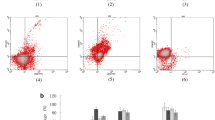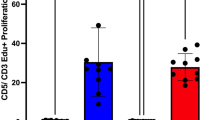Abstract
Tumors often target dendritic cells (DCs) to evade host immune surveillance. DC injury is reported in many rodent and human tumors but seldom in tumors of other mammals. Canine transmissible venereal tumor (CTVT), a unique and spontaneous cancer transmitted by means of viable tumor cells. CTVT causes manifold damage to monocyte-derived DCs. This cancer provides an in vivo model of cancer to study the role of monocyte-derived DCs during spontaneous regression. Using flow cytometry and real-time reverse-transcription polymerase chain reactions, we compared the expression of surface molecules on monocyte-derived DCs between normal dogs and dogs with CTVT. These markers were CD1a, CD83, costimulatory factors (CD40, CD80, and CD86), and major histocompatability complex classes I and II. In immature DCs (iDCs) and lipopolysaccharide-treated mature DCs (mDCs), the surface markers were mostly downregulated during tumoral progression and regression. The tumor lowered endocytic activity of iDCs, as reflected in dextran uptake, and decreased allogeneic mixed lymphocyte reactions of mDCs. In addition, it decreased the number of monocytes in the peripheral blood by 40%. The tumor substantially impaired the efficiency with which DCs were generated from monocytes and with which mDCs were generated from iDCs. We also found that progression-phase CTVT supernatants that were cultured for 48 h and that contained protein components killed both monocytes and DCs. Additionally, DC numbers were significantly lower in the draining lymph nodes in CTVT dogs than in normal dogs. In conclusion, CTVT caused devastating damage to monocyte-derived DCs; this might be one of its mechanisms for evading host immunity. Reestablishment of monocyte-derived DC activity by the host potentially might contribute to spontaneous tumoral regression. These findings provide insight into the extent of tumoral effects on host immune systems and responses. This information is useful for developing cancer immunotherapies.








Similar content being viewed by others
References
Banchereau J, Briere F, Caux C, Davoust J, Lebecque S, Liu YJ, Pulendran B, Palucka K (2000) Immunobiology of dendritic cells. Annu Rev Immunol 18:767–811
Onishi H, Kuroki H, Matsumoto K, Baba E, Sasaki N, Kuga H, Tanaka M, Katano M, Morisaki T (2004) Monocyte-derived dendritic cells that capture dead tumor cells secrete IL-12 and TNF-alpha through IL-12/TNF-alpha/NF-kappaB autocrine loop. Cancer Immunol Immunother 53:1093–1100
Tourkova IL, Shurin GV, Chatta GS, Perez L, Finke J, Whiteside TL, Ferrone S, Shurin MR (2005) Restoration by IL-15 of MHC class I antigen-processing machinery in human dendritic cells inhibited by tumor-derived gangliosides. J Immunol 175:3045–3052
Rossi G, Heveker N, Thiele B, Gelderblom H, Steinbach F (1992) Development of a Langerhans cell phenotype from peripheral blood monocytes. Immunol Lett 31:189–197
Nimura F, Zhang LF, Okuma K, Tanaka R, Sunakawa H, Yamamoto N, Tanaka Y (2006) Cross-linking cell surface chemokine receptors leads to isolation, activation, and differentiation of monocytes into potent dendritic cells. Exp Biol Med (Maywood) 231:431–443
Ferlazzo G, Tsang ML, Moretta L, Melioli G, Steinman RM, Munz C (2002) Human dendritic cells activate resting natural killer (NK) cells and are recognized via the NKp30 receptor by activated NK cells. J Exp Med 195:343–351
Taieb J, Chaput N, Menard C, Apetoh L, Ullrich E, Bonmort M, Pequignot M, Casares N, Terme M, Flament C, Opolon P, Lecluse Y, Metivier D, Tomasello E, Vivier E, Ghiringhelli F, Martin F, Klatzmann D, Poynard T, Tursz T, Raposo G, Yagita H, Ryffel B, Kroemer G, Zitvogel L (2006) A novel dendritic cell subset involved in tumor immunosurveillance. Nature Med 12:214–219
Cella M, Sallusto F, Lanzavecchia A (1997) Origin, maturation and antigen presenting function of dendritic cells. Curr Opin Immunol 9:10–16
Aalamian M, Pirtskhalaishvili G, Nunez A, Esche C, Shurin GV, Huland E, Huland H, Shurin MR (2001) Human prostate cancer regulates generation and maturation of monocyte-derived dendritic cells. Prostate 46:68–75
Kiertscher SM, Luo J, Dubinett SM, Roth MD (2000) Tumors promote altered maturation and early apoptosis of monocyte-derived dendritic cells. J Immunol 164:1269–1276
Mahanonda R, Sa-Ard-Iam N, Yongvanitchit K, Wisetchang M, Ishikawa I, Nagasawa T, Walsh DS, Pichyangkul S (2002) Upregulation of co-stimulatory molecule expression and dendritic cell marker (CD83) on B cells in periodontal disease. J Periodontal Res 37:177–183
Ninomiya T, Akbar SM, Masumoto T, Horiike N, Onji M (1999) Dendritic cells with immature phenotype and defective function in the peripheral blood from patients with hepatocellular carcinoma. J Hepatol 31:323–331
Babatz J, Rollig C, Oelschlagel U, Zhao S, Ehninger G, Schmitz M, Bornhauser M (2003) Large-scale immunomagnetic selection of CD14+ monocytes to generate dendritic cells for cancer immunotherapy: a phase I study. J Hematother Stem Cell Res 12:515–523
Menetrier-Caux C, Montmain G, Dieu MC, Bain C, Favrot MC, Caux C, Blay JY (1998) Inhibition of the differentiation of dendritic cells from CD34(+) progenitors by tumor cells: role of interleukin-6 and macrophage colony-stimulating factor. Blood 92:4778–4791
Um SH, Mulhall C, Alisa A, Ives AR, Karani J, Williams R, Bertoletti A, Behboudi S (2004) {alpha}-Fetoprotein Impairs APC Function and Induces Their Apoptosis. J Immunol 173:1772–1778
Katsenelson NS, Shurin GV, Bykovskaia SN, Shogan J, Shurin MR (2001) Human small cell lung carcinoma and carcinoid tumor regulate dendritic cell maturation and function. Mod Pathol 14:40–45
Harizi H, Juzan M, Pitard V, Moreau JF, Gualde N (2002) Cyclooxygenase-2-issued prostaglandin e(2) enhances the production of endogenous IL-10, which down-regulates dendritic cell functions. J Immunol 168:2255–2263
Takahashi A, Kono K, Ichihara F, Sugai H, Fujii H, Matsumoto Y (2004) Vascular endothelial growth factor inhibits maturation of dendritic cells induced by lipopolysaccharide, but not by proinflammatory cytokines. Cancer Immunol Immunother 53:543–550
Hirano A, Brown WC, Estes DM (1997) Cloning, expression and biological function of the bovine CD40 homologue: role in B-lymphocyte growth and differentiation in cattle. Immunology 90:294–300
Chakraborty A, Li L, Chakraborty NG, Mukherji B (1999) Stimulatory and inhibitory maturation of human macrophage-derived dendritic cells. Pathobiology 67:282–286
Larmonier N, Marron M, Zeng Y, Cantrell J, Romanoski A, Sepassi M, Thompson S, Chen X, Andreansky S, Katsanis E (2007) Tumor-derived CD4+CD25+ regulatory T cell suppression of dendritic cell function involves TGF- and IL-10. Cancer Immunol Immunotherapy 56:48–59
Howell JM, Ishmael J, Joshua JO (1969) Transmissible venereal tumour of dogs. Vet Rec 84:418–419
Murgia C, Pritchard J, Kim SY, Fassati A, Weiss RA (2006) Clonal Origin and Evolution of a Transmissible Cancer. Cell 126:477–487
Chu RM, Lin CY, Liu CC, Yang SY, Hsiao YW, Hung SW, Pao HN, Liao KW (2001) Proliferation characteristics of canine transmissible venereal tumor. Anticancer Res 21:4017–4024
Cohen D (1985) The canine transmissible venereal tumor: a unique result of tumor progression. Adv Cancer Res 43:75–112
Hsiao YW, Liao KW, Hung SW, Chu RM (2004) Tumor-infiltrating lymphocyte secretion of IL-6 antagonizes tumor-derived TGF-beta1 and restores the lymphokine-activated killing activity. J Immunol 172:1508–1514
Hsiao YW, Liao KW, Hung SW, Chu RM (2002) Effect of tumor infiltrating lymphocytes on the expression of MHC molecules in canine transmissible venereal tumor cells. Vet Immunol Immunopathol 87:19–27
Bonnefont-Rebeix C, de Carvalho CM, Bernaud J, Chabanne L, Marchal T, Rigal D (2006) CD86 molecule is a specific marker for canine monocyte-derived dendritic cells. Vet Immunol Immunopathol 109:167–176
Wang YS, Chi KH, Liao KW, Liu CC, Cheng CL, Lin YC, Cheng CH, Chu RM (2007) Characterization of canine monocyte-derived dendritic cells with phenotypic and functional differentiation. Can J Vet Res 71:165–174
Hagglund HG, McSweeney PA, Mathioudakis G, Bruno B, Georges GE, Gass MJ, Moore P, Sale GE, Storb R, Nash RA (2000) Ex vivo expansion of canine dendritic cells from CD34+ bone marrow progenitor cells. Transplantation 70:1437–1442
Liao KW, Hung SW, Hsiao YW, Bennett M, Chu RM (2003) Canine transmissible venereal tumor cell depletion of B lymphocytes: molecule(s) specifically toxic for B cells. Vet Immunol Immunopathol 92:149–162
Livak KJ, Schmittgen TD (2001) Analysis of relative gene expression data using real-time quantitative PCR and the 2(-Delta Delta C(T)) Method. Methods 25:402–408
Nikitina EY, Gabrilovich DI (2001) Combination of gamma-irradiation and dendritic cell administration induces a potent antitumor response in tumor-bearing mice: approach to treatment of advanced stage cancer. Int J Cancer 94:825–833
Pinzon-Charry A, Maxwell T, Lopez JA (2005) Dendritic cell dysfunction in cancer: a mechanism for immunosuppression. Immunol Cell Biol 83:451–461
Della Bella S, Gennaro M, Vaccari M, Ferraris C, Nicola S, Riva A, Clerici M, Greco M, Villa ML (2003) Altered maturation of peripheral blood dendritic cells in patients with breast cancer. Br J Cancer 89:1463–1472
Esche C, Shurin MR, Lotze MT (1997) B16 melanoma induces downregulation of beta2 integrin and ICAM-1 expression on murin dendritic cells. J Investig Dermatol 108:640
Chaux P, Favre N, Bonnotte B, Moutet M, Martin M, Martin F (1997) Tumor-infiltrating dendritic cells are defective in their antigen-presenting function and inducible B7 expression. A role in the immune tolerance to antigenic tumors. Adv Exp Med Biol 417:525–528
Kato M, Neil TK, Fearnley DB, McLellan AD, Vuckovic S, Hart DN (2000) Expression of multilectin receptors and comparative FITC-dextran uptake by human dendritic cells. Int Immunol 12:1111–1113
Mohty M, Jarrossay D, Lafage-Pochitaloff M, Zandotti C, Briere F, de Lamballeri XN, Isnardon D, Sainty D, Olive D, Gaugler B (2001) Circulating blood dendritic cells from myeloid leukemia patients display quantitative and cytogenetic abnormalities as well as functional impairment. Blood 98:3750–3756
Vicari AP, Caux C, Trinchieri G (2002) Tumour escape from immune surveillance through dendritic cell inactivation. Semin Cancer Biol 12:33–42
Bohnenkamp HR, Burchell JM, Taylor-Papadimitriou J, Noll T (2004) Apoptosis of monocytes and the influence on yield of monocyte-derived dendritic cells. J Immunol Methods 294:67–80
Muta M, Matsumoto G, Nakashima E, Toi M (2006) Mechanical analysis of tumor growth regression by the cyclooxygenase-2 inhibitor, DFU, in a Walker256 rat tumor model: importance of monocyte chemoattractant protein-1 modulation. Clin Cancer Res 12:264–272
Lans TE, Van Horssen R, Eggermont AM, Ten Hagen TL (2004) Involvement of endothelial monocyte activating polypeptide II in tumor necrosis factor-alpha-based anti-cancer therapy. Anticancer Res 24:2243–2248
Micheva I, Thanopoulou E, Michalopoulou S, Karakantza M, Kouraklis-Symeonidis A, Mouzaki A, Zoumbos N (2004) Defective tumor necrosis factor alpha-induced maturation of monocyte-derived dendritic cells in patients with myelodysplastic syndromes. Clin Immunol 113:310–317
Ito M, Minamiya Y, Kawai H, Saito S, Saito H, Nakagawa T, Imai K, Hirokawa M, Ogawa J (2006) Tumor-derived TGFbeta-1 induces dendritic cell apoptosis in the sentinel lymph node. J Immunol 176:5637–5643
Roberts AB, Anzano MA, Meyers CA, Wideman J, Blacher R, Pan YC, Stein S, Lehrman SR, Smith JM, Lamb LC et al (1983) Purification and properties of a type beta transforming growth factor from bovine kidney. Biochemistry 22:5692–5698
Frick JS, Zahir N, Muller M, Kahl F, Bechtold O, Lutz MB, Kirschning CJ, Reimann J, Jilge B, Bohn E, Autenrieth IB (2006) Colitogenic and non-colitogenic commensal bacteria differentially trigger DC maturation and Th cell polarization: an important role for IL-6. Eur J Immunol 36:1537–1547
Wright SD, Ramos RA, Tobias PS, Ulevitch RJ, Mathison JC (1990) CD14, a receptor for complexes of lipopolysaccharide (LPS) and LPS binding protein. Science 249:1431–1433
Duperrier K, Velten FW, Bohlender J, Demory A, Metharom P, Goerdt S (2005) Immunosuppressive agents mediate reduced allostimulatory properties of myeloid-derived dendritic cells despite induction of divergent molecular phenotypes. Mol Immunol 42:1531–1540
Velten FW, Duperrier K, Bohlender J, Metharom P, Goerdt S (2004) A gene signature of inhibitory MHC receptors identifies a BDCA3(+) subset of IL-10-induced dendritic cells with reduced allostimulatory capacity in vitro. Eur J Immunol 34:2800–2811
Acknowledgments
This research was supported by the National Science Council, Taiwan, ROC (NSC 95-2323-B-002-025).
Author information
Authors and Affiliations
Corresponding author
Additional information
C.-C. Liu and Y.-S. Wang contributed equally.
Rights and permissions
About this article
Cite this article
Liu, CC., Wang, YS., Lin, CY. et al. Transient downregulation of monocyte-derived dendritic-cell differentiation, function, and survival during tumoral progression and regression in an in vivo canine model of transmissible venereal tumor. Cancer Immunol Immunother 57, 479–491 (2008). https://doi.org/10.1007/s00262-007-0386-0
Received:
Accepted:
Published:
Issue Date:
DOI: https://doi.org/10.1007/s00262-007-0386-0




